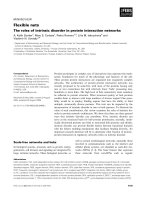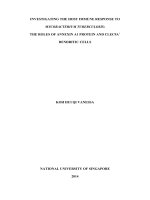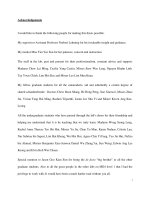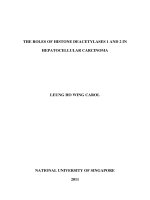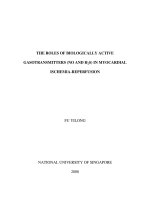The roles of a global ph sensor protein chvg in homologous recombination and mutation of agrobacterium tumefaciens
Bạn đang xem bản rút gọn của tài liệu. Xem và tải ngay bản đầy đủ của tài liệu tại đây (3.3 MB, 209 trang )
The Roles of a Global pH Sensor
Protein ChvG in Homologous Recombination and Mutation
of
Agrobacterium tumefaciens
Li Xiaobo
(B. Sc.,Nanjing University)
A THESIS SUBMITTED
FOR THE DEGREE OF DOCTOR OF PHILOSOPHY
DEPARTMENT OF BIOLOGICAL SCIENCES
NATIONAL UNIVERSITY OF SINGAPORE
2006
ACKNOWLEDGEMENTS
First of all, my deepest gratitude goes to my supervisor, Associate Professor Pan
Shen Quan, not only for giving me the opportunity to undertake this interesting
project but also for his patience, encouragement, practical and professional guidance
throughout my Ph. D candidature.
Secondly, I would like to express my heartfelt gratitude to Professor Wong Sek
Man, for his patient guidance on my research project.
I also appreciate A/P Hong
Yunhan, A/P Ge Ruowen, Assistant Professor Low Boon Chuan and Assistant
Professor Yu Hao for giving me instructions during my study.
I would also like to thank the following friends and members in my laboratory
who have helped me in one way or another: Alan John Lowton, Chang Limei, Guo
Minliang, Hou Qingming, Jia Yonghui, Li Luoping, Lin Su, Qian Zhuolei, Tan Lu
Wee, Sun Deying, Tang Hock Chun, Tu Haitao, Wang Long, and Yang Kun.
Special thanks are given to Alan and Hock Chun for proofreading this thesis.
I want
to thank the friends from other laboratories who have assisted me in many ways too.
Finally, I thank the National University of Singapore for awarding me a research
scholarship to carry out this interesting project.
i
TABLE OF CONTENTS
Acknowledgements
i
Table of Contents
ii
Summary
vii
List of Tables
ix
List of Figures
x
List of Abbreviations
Chapter 1. Literature Review
1.1. Overview of homologous recombination
xii
1
3
1.1.1. Biochemical models of homologous recombination: (i) DNA strand
invasion mechanism
5
1.1.2. Biochemical models of homologous recombination: (ii) DNA strandannealing mechanism
8
1.2. Overview of premutagenic damage causes
12
1.2.1. Replication errors made during normal DNA synthesis
13
1.2.2. Spontaneous DNA lesion
16
1.3. Overview of adaptive mutation
20
1.3.1. The beginning of modern adaptive mutation study
20
1.3.2. Classical lac reversion model of adaptive mutation in E. coli
22
1.3.3. Features of adaptive point mutation in the classical lac system in E.
24
1.3.4. Adaptive point mutation requires homologous recombination proteins
24
1.3.5. Adaptive mutation in FC40 requires conjugal function but not actual
conjugation
26
1.3.6. Adaptive mutation produces mostly −1 deletion in small nucleotide
repeats
28
1.3.7. SOS response regulates adaptive mutation
30
1.3.8. Mismatch repair is limited transiently during adaptive mutation
32
coli
ii
1.3.8.1. Overview of mismatch directed repair
32
1.3.8.2. MutL becomes limiting during stationary-phase mutation
33
1.3.8.3. Study of mismatch repair in stationary phase in other assay
36
system
1.3.9. Hypermutation sub-population
38
1.3.10. Features of adaptive amplification in classical lac system in E. coli
41
1.3.10.1. Hypothesis that adaptive amplification is the intermediate of
point mutation
43
1.3.10.2. Evidence showing that adaptive amplification is a separate
strategy
44
1.4. Overview of two-component system
45
1.4.1. General overview of two-component systems in prokaryotic cells
46
1.4.2. Structure and activities of sensor histidine protein kinase (HPK)
51
1.4.2.1. The kinase core module
51
1.4.2.2. Sensing domain
53
1.4.3. Linker domain
53
1.4.4. Structure and activities of response regulator proteins (RRs)
54
1.4.5. Two-component systems identified in A. tumefaciens
55
1.4.5.1. VirA/VirG is the first two-component system identified in A.
tumefaciens
56
1.4.5.2. ChvG/ChvI is the second two-component system detected in A.
tumefaciens
57
1.5. Objectives of this study
Chapter 2. General Materials and Methods
61
63
2.1. Bacterial strains, plasmids, media and antibiotics
63
2.2. DNA manipulations
69
iii
2.2.1. Plasmid DNA preparation
69
2.2.2. Genomic DNA preparation from Agrobacterium
69
2.2.3. DNA digestion
70
2.2.4. Polymerase chain reaction
70
2.2.5. DNA gel electrophoresis and purification
72
2.2.6. Preparation of competent E. coli cells
73
2.2.7. Transformation of E. coli
74
2.2.8. Sequencing
74
Chapter 3. ChvG can affect homologous recombination
75
3.1. Introduction
75
3.2. Materials and methods
76
3.2.1. Tri-parental mating
76
3.2.2. Preparation of electrocompetent A. tumefaciens cells
76
3.2.3. Transformation of electrocompetent A. tumefaciens cells with
plasmid DNA or total DNA by electroporation
77
3.3. Results
78
3.3.1. ChvG can affect of RecA-dependent homologous recombination
78
3.3.2. ChvG can also affect RecA-independent DNA recombination
83
3.3.3. ChvG does not affect recombination-independent conjugation process
84
3.4. Discussion
Chapter 4. ChvG can regulate mutation both in rapid growth phase and in
starvation
4.1. Introduction
4.1.1. Overview about transposition
86
90
90
91
iv
4.1.2. Three classes of transposable elements
92
4.1.3. Regulation mechanisms of transposition in bacteria
93
4.1.4. Host factors that affect the transposition
98
4.2. Materials and methods
101
4.2.1. Mutation assay and calculation of mutation frequency
101
4.2.2. Calculation of mutation rate (µ)
101
4.2.3. Random mutagenesis of Agrobacterium tumefaciens with mini-Tn5
transposon
102
4.2.4. Selection of mini-Tn5-inserted mutants with changed mutation
phenotype to tetracycline
103
4.2.5. Stationary-phase mutation assay
104
4.2.5.1. Stationary-phase mutation assay
104
4.2.5.2. Estimation of the viable cell number during stationary-phase
mutation assay
105
4.2.6. Norfloxacin resistance mutation assay
106
4.2.7. Semi-quantitative RT-PCR
106
4.2.7.1. RNA fixation for Agrobacterium tumefaciens cells
106
4.2.7.2. RNA isolation from Agrobacterium tumefaciens cells
107
4.2.7.3. cDNA synthesis
108
4.2.7.4. PCR amplification using synthesized cDNA as the substrate and
the comparison of the transcription level of target genes
108
4.2.8. Tetracycline accumulation assay
110
4.2.8.1. Standard absorbance curve of tetracycline solution
110
4.2.8.2. Determination of tetracycline internal accumulation
110
4.3. Results
4.3.1. Mutation at chvG locus severely lowers the tetracycline-resistance
mutation frequency in MG/L rich media but not in AB minimal media
111
111
v
4.3.2. Calculation of the mutation rate of the chvG− strain and the wild type
strain
117
4.3.3. Mutagenesis of A. tumefaciens with mini-Tn5 transposon
119
4.3.4. chvG+ and chvG− strains show different mutation spectra
124
4.3.5. Sequence analysis of the tetracycline-resistant mutants of chvG+ and
chvG− strains
132
4.3.6. No significant difference in the transcription level of Tc-resistant
mutation-related genes between chvG+ and chvG− strains
135
4.3.7. No significant difference in the transcription level of two IS426
putative transposases between chvG+ and chvG− strains
138
4.3.8. Comparison of the capacity of point mutation using norfloxacin as the 142
selection force
4.3.9. ChvG can regulate stationary-phase mutation too
4.4. Discussion
147
155
4.4.1. The implication that a similar mutation level occurs at a specific
locus via different mutation mechanisms in different strains
155
4.4.2. Tentative explanation for the difference in point mutation level
158
4.4.3. The potential coupling of hypermutation and transposition
162
4.4.4. Membrane permeability assay is the important control experiment in
our mutation assay
165
Chapter 5. General conclusions and future perspective
170
5.1. General conclusions
170
5.2. Future perspective
172
Reference
173
vi
Summary
The process of homologous recombination is essential to all organisms. Yet
despite the extreme importance of homologous recombination, relatively less is
known about its biological regulation.
In the current research project, we studied the effect of ChvG, the sensor protein
of ChvG-ChvI two-component system of Agrobacterium tumefaciens, on the
regulation of homologous gene recombination.
Gene recombination efficiency was compared between chvG+ and chvG−
strains, exploiting general recombination (RecA-dependent) and intramolecular
recombinogenic recombination (IRR) (RecA-independent) as well. chvG+ strain was
found to possess a much higher DNA recombination capacity. These results suggest
that loss of a functional ChvG may interfere with one or more key steps of
homologous recombination process.
Mutation is also a fundamental biological process and it drives the evolution
forward. However, mutation is also a complicated biological process. In the current
study, we took the advantage of tetR-tetA operon to explore the potential role played
by ChvG protein in the regulation of mutation process occurring in A.
tumefaciens.
Our mutation assay system is superior to some conventional reverse mutation assay
systems. This is because that most of reversion mutation systems are not satisfactory
for determining mutational spectra in that for a given mutation, there are a very
limited sites and/or kinds of mutations that can produce a reversion. Some important
sources of mutation, such as insertion of transposable element, are usually thoroughly
excluded from the study that employs the reversion system.
In our experiments, firstly, the mutation phenotype was compared between
chvG+ strain A6007 and chvG− derivative strain A6340. It is found that if selection
vii
was conducted on a rich medium
(MG/L), the wild type strain showed a much
higher mutation frequency. However on simple selective media (AB), a comparable
mutation level was obtained. This suggests that the fitness under selection makes the
substantial contribution to the final mutation result. In order to analyze the molecular
basis of mutation, PCR and sequencing were utilized. For wild type strain A6007,
more than 90% mutants were point mutants; while for chvG− strain A6340, more than
90% mutants accorded to insertion of transposons. This different mutation pattern
implies that bacteria strains could have evolved to be capable to invoke to various
mutation mechanisms to keep a constant mutation rate at a specific genome locus.
Mutation assay was further extended to the stationary-phase because there
may be fundamental difference in terms of origin of mutation arising at these two
growth phases. To do this, wild type strain and chvG− strain were starved on agar
plates without readily-usable carbon source and the time course of mutation frequency
and mutation spectra were tracked continuously. Loss of functional ChvG was found
to be able to render bacterial cells a hypermutation state during starvation. In addition,
at stationary phase, most of mutation occurring in chvG wild type strain was
insertion-mediated, just like the situation observed in chvG− strain during exponential
growth. Our finding bears on the evolutionary significance because bacterial
population usually spends most of its time in kinds of stress in its natural niches.
viii
LIST OF TABLES
Table 1.1.
Recombination components
Table 2.1.
Bacterial strains and plasmids
64
Table 2.2.
Media preparation
66
Table 2.3.
Antibiotics and other stock solutions used in this study
68
Table 3.1.
The efficiency or frequency of homologous recombination,
IRR, conjugation and mutation
82
Table 4.1.
Host factors involved in transposition
100
Table 4.2.
Tetracycline-resistance mutation frequency and the effect of
composition of the growth media or selection media on
mutation frequency
116
Table 4.3.
Fluctuation assay
118
Table. 4.4.
Mutation phenotypes
derivative strains
Table 4.5.
Mutation spectra and the distribution of various mutations
131
Table 4.6.
Mutation capacity of mini-Tn5-inserted derivative strains of
A6007
146
Table 4.7.
Time course of mutation under starvation
154
of
4
mini-Tn5-containing
A6007
123
ix
LIST OF FIGURES
Fig. 1.1.
DNA strand invasion mechanism
6
Fig. 1.2.
DNA strand-annealing mechanism
11
Fig. 1.3.
Mutation theory
12
Fig. 1.4.
Gel kinetic assay
15
Fig. 1.5.
Two-component phosphotransfer schemes
50
Fig. 1.6.
Diagrammatical presentation of predicted ChvG domains
59
Fig. 3.1.
The efficiency of homologous recombination
79
Fig. 3.2.
Recombination funcitions in adaptive mutation
89
Fig. 4.1.
Two kinds of transposition: cut & paste transposition and
replicative conintegration
94
Fig. 4.2.
The effect of the growth media and selection media on mutation
frequency
115
Fig. 4.3.
Structure of the promoter-probe gfp-based mini-transposon
pAG408
120
Fig. 4.4.
Mutation phenotypes of mini-Tn5-inserted A6007 derivative
strains
121
Fig. 4.5.
Genetic organization of the tet operon
125
Fig. 4.6.
PCR products of Tc-resistant mutant colonies of A. tumefaciens
strains A6007, A6340, 483, 715, TcM3 and TcM5
127
Fig. 4.7.
Pentose pathway and Entner-Doudoroff pathway
129
Fig. 4.8.
Sequencing result of tetR locus of Tc-resistant colonies of the
chvG+ strain A6007 and the chvG− strain A6340
133
Fig. 4.9.
Comparison of transicription level of Tc mutation-related genes
between chvG+ and chvG− strains
137
Fig. 4.10.
Insertion of IS426 in tetR and genetic organization of IS426
139
Fig. 4.11.
Transcription level of two IS426 putative transposases between
chvG+ and chvG− strains
141
Fig. 4.12.
Mutation under a serial concentration of tetracycline and
143
x
norfloxacin
Fig. 4.13.
Starvation mutation assay
149
Fig. 4.14.
Mutation pattern at stationary phase
152
Fig. 4.15.
Growth curve of the chvG+ strain A6007 and the chvG− strain
A6340 in AB minimal medium or in MG/L rich media
159
Fig. 4.16.
Uptake of tetracycline by Escherichia coli
168
xi
LIST OF ABBREVIATIONS
A
Adenosine
kb
kilobase(s) or 1000 bp
A
absorbance (1cm)
kDa
kilodalton(s)
aa
amino acid(s)
Km
kanamycin
Amp
Ampicillin
lacZ
β-galactosidase gene
AP
Alkaline phosphatase
M
molar
bp
base pair(s)
MCS
multiple cloning site(s)
BSA
bovine serum albumin
mg
milligram(s)
C- terminal
carboxyl terminal
µ
micro-
Cb
Carbenicillin
µg
microgram(s)
cfu
colony-forming unit(s)
µl
microliter(s)
Chl
Chloramphenical
µm
micrometre
DMSO
Dimethylsulfoxide
min
minute(s)
DNA
deoxyribonucleic acid
ml
milliliter(s)
dNTP
Deooxyribonucleoside
triphosphate
mM
millimole
dsDNA
double-stranded DNA
mw
molecular weight
EDTA
EtBr
Ethylenediaminetetra acetic N
acid
ethidium bromide
n
Nano-
EtOH
Ethanol
nanometer
g
grams or gravitational force, nt
according to the intended
meaning
nucleotide(s)
G
Guanosine
N- terminal
amino terminal
Gm
Gentamycin
Oligo
oligodeoxyribonucleotide
h
hour(s)
ORF
open reading frame
p
pico-
phoA
alkaline phosphatase
nm
any nucleoside
xii
r
resistant/resistance gene
RBS
ribosome-binding site(s)
Rf
Rifampicin
RNA
ribonucleic acid
RNase
Ribonuclease
rpm
revolutions per minute
RT
S
room temperature
sensitive/sensitivity
SDS
sodium dodecyl sulfate
sec
second(s)
ssDNA
single-stranded DNA
T
Thymidine
1× TAE
SDS 40 mM Tris-acetate, 1
mM EDTA
TBS
Tris-buffered saline
Tc
Tetracycline
Tn
Transposon
UV
Ultraviolet
V/V
volume per volume
w/v
weight per volume
wt
wild type
xiii
Chapter 1. Literature Review
The process of homologous genetic recombination is essential to all kinds of
organisms. Most of homologous recombination events are mediated by RecAdependent pathways that require large regions of homology between the donor and the
recipient DNA (Kowalczykowski et al., 1994). The loss of recA through mutation
reduces the recombination frequency by 99.9% (Moat et al., 2002). The process of
RecA-dependent homologous recombination can be viewed in six steps: (1) strand
breakage, (2) strand pairing, (3) strand invasion/assimilation, (4) chiasma or crossover
formation, (5) breakage and reunion, and (6) mismatch repair.
Although RecA is the core component for genetic recombination, there is also
RecA-independent mechanism for gene recombination. Intramolecular
recombinogenic recircularization (IRR) is a kind of RecA-independent homologous
recombination, which occurs at short DNA repeats (4-10 bp) (McFarlane and
Saunders, 1996). The underlying mechanism for IRR could be DNA strand-annealing,
in which the exonuclease activity could be provided by proteins (such as exonuclease
III) other than RecA (Conley et al., 1986).
Just like gene recombination, mutagenesis is also fundamental to all organisms,
because it generates variability that conditions all evolutionary change (Drake, 1991).
During growth of an organism, DNA can be damaged by a variety of factors. Any
heritable change in the nucleotide sequence of a gene is called mutation regardless of
whether there is an observable change in the characteristic (phenotype) of the
organism. Mutation themselves come in a variety of different forms. A change in a
single base is a point mutation. A point mutation could be a transition that involves
changing a purine to a different purine or a pyrimidine to a different pyrimidine. A
transversion is a point mutation where a purine is replaced by a pyrimidine or vice
1
versa. If a mutation process causes the removal of a series of nucleotides in a
sequence, the result is a deletion mutation. Likewise, the addition of extra bases into a
sequence is an addition or insertion mutation.
Mutations can be classified into two categories according to the time of their
occurring (Rosenberg, 2001). If the mutation occurs at the exponential growing phase,
it is normally called spontaneous mutation. If the mutation occurs in cells without
growing or only slowly growing, it is called an adaptive or stationary-phase mutation.
It is necessary to point out that adaptive mutation is not directed. In other words,
adaptive mutation also has an underlying random basis that does not invoke true
directed mutations.
With the accumulation of the knowledge of homologous gene recombination
and mutation, one important question arises: whether these are regulated biological
processes, as many other biological processes. Among bacterial signal transduction
systems, two-component systems are of prime importance in transmitting
environmental signals and adjusting adaptive responses. The availability of complete
genome sequences has allowed definitive assessment of the prevalence of twocomponent proteins. We believe that two-component systems are the potential
candidates that play important roles in regulating homologous recombination and
mutagenesis.
This review serves as an introduction to homologous recombination,
spontaneous recombination, adaptive mutation and bacterial two-component systems
(two-component systems in A. tumefaciens are reviewed as examples). Because
adaptive mutation is relatively new research topic and may bear on important
evolutionary significance, a relatively more detailed knowledge review is provided
.
2
1.1. Overview of homologous recombination
Homologous recombination is essential to all organisms, because it is important
for generation of genetic diversity, the maintenance of genomic integrity, and the
proper segregation of chromosomes (Okada and Keeney, 2005). Especially DNA
double-strand breaks (DSB) and single-stranded gaps are efficient initiators of
homologous recombination, which results in their accurate repair using an intact
homologous template in the same cell (Symington, 2002). Yet despite the importance
of homologous recombination, the details of molecular mechanisms underlying the
process are not easy to obtain because (i) the isolation and characterization of
homologous recombination intermediate proved to be impractical because of their
complexity and/or lability; (ii) homologous recombination involves a multitude of
genes, which in many cases, have overlapped functions. Nevertheless, recently the
combination of genetic, molecular and biochemical analyses has revealed a detailed
picture of this central biological process (Moat et al., 2002).
Interestingly, to the date, in most cases genes identified as important one in
homologous recombination was not involved in other biological processes but, instead,
had been shown to be uniquely important to recombination or recombinational repair
(Kowalczykowski et al., 1994). The current list of components needed for efficient
genetic exchange is summarized in Table 1.1.
3
Table 1.1. Recombination components
Components
RecA
RecBCD (exonuclease V)
RecBC
RecE (exonuclease VIII)
RecF
RecG
RecJ
RecN
RecO
RecQ
RecR
RecT
RuvA
RuvB
RuvC
SbcB (exonuclease I )
SbcCD
SSB
DNA topoisomerase I
DNA gyrase
DNA ligase
DNA polymerase I
Helicase II
Helicase IV
Chi (χ)
Activity
DNA strand exchange; DNA
renaturation; DNA dependent ATPase;
DNA- and ATP-dependent coprotease
DNA helicase; ATP-dependent
dsDNA and ssDNA exonuclease; ATPdependent ssDNA endonuclease; χ hot
spot recognition
DNA helicase
dsDNA exonuclease, 5’→3’ specific
ssDNA and dsDNA binding; ATP
binding
Brand migration of Holiday
junction; DNA helicase
ssDNA exonuclease, 5’→3’ specific
Unknown function
Interaction with RecR
DNA helicase
Interaction with RecO
DNA renaturation
Holliday-, cruciform- and four-way
junction binding; interaction with RuvB
Branch migration of Holiday
junction; DNA helicase; interaction with
RuvA
Holliday junction cleavage; fourway junction binding
ssDNA exonuclease,3’→5’ specific;
deoxyribophosphodiesterase
ATP-dependent dsDNA
exonuclease
ssDNA binding
Type I topoisomerase
Type II topoisomerase
Ligase
DNA polymerase, 3’→5’ or 5’→3’
exonuclease
Helicase
Helicase
Recombination hot spot(5’GCTGGTGG-3’); regulator of RecBCD
holoenzyme nuclease activity
(adapted from Moat et al., 2002)
4
1.1.1.
Biochemical models of homologous recombination: (i) DNA strand
invasion mechanism
The original model of homologous recombination envisioned ssDNA breaks as
the initiators of DNA exchange (Holliday, 1964). Subsequently, dsDNA break repair
model was proposed which envisioned a dsDNA break followed by exonucleolytic
degradation as the initiator of recombination events (Resnick, 1976; Szostak et al.,
1983). Actually, this modification was supported by the observation that in E. coli, the
recombination during conjugation or transduction or between λ phage was initiated at
dsDNA breaks (Thaler and Stahl, 1988). Thus, DNA invasion model can be
simplified as the reaction between a linear dsDNA molecule and a supercoiled DNA
molecule (Fig. 1.1). dsDNA break repair model can be divided into four steps: (i)
initiation (substrate processing); (ii) homologous pairing and DNA exchange; (iii)
DNA heteroduplex extension (branch migration); and (iv) resolution.
The initiation is the process which converts dsDNA to ssDNA suitable for RecA
function. This step actually can be accomplished by a few pathways. In wild type E.
coli cells, the combined helicase activity and nuclease activity of RecBCD convert
intact dsDNA into unwound dsDNA (Taylor and Smith, 1980). RecBCD unwinds and
degrades linear dsDNA asymmetrically until it encounters a χ sequence (Dixon and
Kowalczykowski, 1991). χ sequence(5’-GCTGGTGG-3’) is a regulatory sequence
which can attenuate the nuclease activity but not the helicase activity of RecBCD
holoenzyme (Dixon and Kowalczykowski, 1991). The degradation done by RecBCD
results in the generation of ssDNA terminating near χ with the 3’ invasive end that is
preferred for RecA-dependent invasion of supercoiled DNA (for example,
chromosome DNA)
5
Fig. 1.1. DNA strand invasion mechanism (cited from Kowalczykowski et al., 1994)
6
(Dixon and Kowalczykowski, 1993; Ponticelli et al., 1985). It is worth noting that the
ssDNA released by RecBCD is trapped, bound and protected by RecA or SSB, so it is
not degraded by other cellular nuclease. ssDNA can also be generated by other
pathways even without the involvement of a nuclease. For example, in the absence of
the unwinding function provided by RecBCD, RecQ can work as a helicase to rescue
the otherwise destroyed recombination pathway (Umezu et al., 1990). Also possible
means to generate an ssDNA can be a nuclease action without the facilitation of the
helicase. For example, the product of recE gene is a dsDNA exonuclease. RecE
processively degrades the 5’-terminal strand of dsDNA to produce a molecule with a
3’ ssDNA tail, which is the preferred substrate for RecA-dependent invasion of the
supercoiled recipient DNA (Joseph JW and Kolodner, 1983). Another alternative to
generate ssDNA is the combination of the action of RecQ, a helicase with the action
of RecJ, a recombination specific nuclease.
After generating an ssDNA end (RecA bound), the next recombination step is
the strand invasion of the supercoiled DNA by the 3’ end of the newly produced
ssDNA to form a functional recombination complex. The RecA protein, aided by SSB
(single strand binding) protein, can polymerize on ssDNA, forming a presynaptical
complex. Interestingly, because RecA polymerization on ssDNA is polarized (5’ to 3’)
(Register and Griffith, 1985) and the initial RecA binding is random, the 3’ end of
ssDNA is always more likely to be coated by RecA, contributing to seemingly more
invasive 3’ end (Konforti and Davis, 1987; Konforti and Davis, 1990). The
presynaptical complex then conducts rapid homology search within the adjacent
supercoiled DNA (for example, chromosome DNA) that results in a formation of a
joint molecule. Once such a homology is found, joint molecule can give rise to a
7
Holliday junction by pairing of the strand displaced from dsDNA with invasive
ssDNA (West et al., 1982), which is the formation of heteroduplex.
The third step is the extension of heteroduplex region, which is virtually the
strand exchange between the homologous molecules. Branch migration actually can
occur without the facilitation of enzymes, but the thermal movement is rather slow
(Müller et al., 1992) and bidirectional (Panyutin and Hsieh, 1993). In contrast, RecAdependent heteroduplex extension is rapid and unidirectional (Cox and Lehman, 1981)
and can allow the large region of heteroduplex (several hundred nucleotides) (Bianchi
and Radding, 1983). In addition to RecA, branch migration is also promoted by other
helicase(s). In E. coli, RuvAB holoenzyme can promote RecA-promoted heteroduplex
extension by about 5 folds (Tsaneva et al., 1992). Besides, RecG seems to be another
branch migration protein (Lloyd and Sharples, 1993). However, RecG has the
propensity for the reversal of RecA-mediated DNA strand extension, diminishing the
heteroduplex formed by RecA and RuvAB (Whitby et al., 1993).
The final step is the nucleolytic resolution of joint molecules (Holliday
junction). Symmetric cleavage yields recombinant progenies that either have
undergone the exchange of flanking markers and contain heteroduplex DNA (spliced
molecules) or have simply exchanged ssDNA strands, resulting in heteroduplex DNA
(patched molecules). Holliday junction-cleavage enzyme RuvC seems to be in charge
of this step (Connolly et al., 1991; Connolly and West, 1990).
1.1.2.
Biochemical models of homologous recombination: (ii) DNA strandannealing mechanism
Conservative homologous recombination model maintains the DNA molecules
(even nucleotides) in the process, but the actual homologous recombination processes
need not always be very preserved (Stahl et al., 1990). Intramolecular recombination
8
between directly repeated sequences in plasmids can recombine through a DNA
strand-annealing mechanism (Keim and Lark, 1990) (Fig. 1.2). Such recombination
process can be accomplished in three consecutive steps: (i) initiation-generation of
ssDNA end; (ii) renaturation, and (iii) repair and ligation.
A prerequisite for DNA strand-annealing model is either a dsDNA break or an
ssDNA break which can be subsequently converted to a dsDNA break. As in DNA
strand invasion model, the generation of ssDNA can occur by a few alternative means.
A simple means is to use strand-specific dsDNA exonuclease to degrade one strand
and thus produce an ssDNA end. In E. coli, this strand-specific exonuclease activity
could be provided by RecE (Kowalczykowski et al., 1994). An alternative to produce
ssDNA from a dsDNA break could be that a DNA helicase, such as RecQ which
unwinds the dsDNA and this action is in concert with a 5’→3’ ssDNA necleolytic
degradation provided by a nuclease, such as RecJ. Furthermore, a helicase, such as
RecQ alone, may suffice to produce an ssDNA end, a process functionally mimicking
the previous two means (Kowalczykowski et al., 1994). Theoretically, RecBCD
should also be a component involved in the ssDNA end generation. However, this
was found to be the case in recD− cells (Amundsen et al., 1986; Lovett et al., 1988),
which means that the strong exonuclease activity of RecBCD may be too much for
producing a functional 3’ end in DNA strand-annealing model.
The second step in the annealing pathway requires proteins which are capable of
re-annealing ssDNA. The first candidate could be RecA, because in addition to its
unique strand exchange activity, it also promotes DNA renaturation which is
stimulated by ATP (Weinstock et al., 1979). The second candidate responsible for
renaturation is RecT protein (Hall et al., 1993). In addition, RecT was also found to
be able to carry out strand exchange/strand displacement, resulting in the extension of
9
heteroduplex DNA into regions of dsDNA (Hall and Kolodner, 1994) (Fig. 1.2). The
final candidate for renaturation might be SSB protein, since it is also capable of DNA
renaturation and it is adjacent to recombination core (Christiansen and Baldwin, 1977).
The final step requires the repair of the annealed DNA followed by ligation. In
this step, replicative repair is needed if resection by the nuclease progresses beyond
the first sequence overlap (Fig. 1.2). Polymerase I is a candidate for this replication
(Joyce et al., 1982). Any ssDNA tails remaining after reannealing should be degraded
by ssDNA-specific nuclease, such as RecJ. Polymerase I is also a candidate for this
step because it can endonucleolytically cleave ssDNA at the junction of dsDNA,
provided that the ssDNA tail has a free 5’ terminus (Lyamichev et al., 1993).
Subsequent ligation of the molecule would produce a product with heteroduplex if
any region beyond non-complementary reannealed.
10
Fig. 1.2. DNA strand-annealing mechanism (cited from Kowalczykowski et al., 1994)
11
